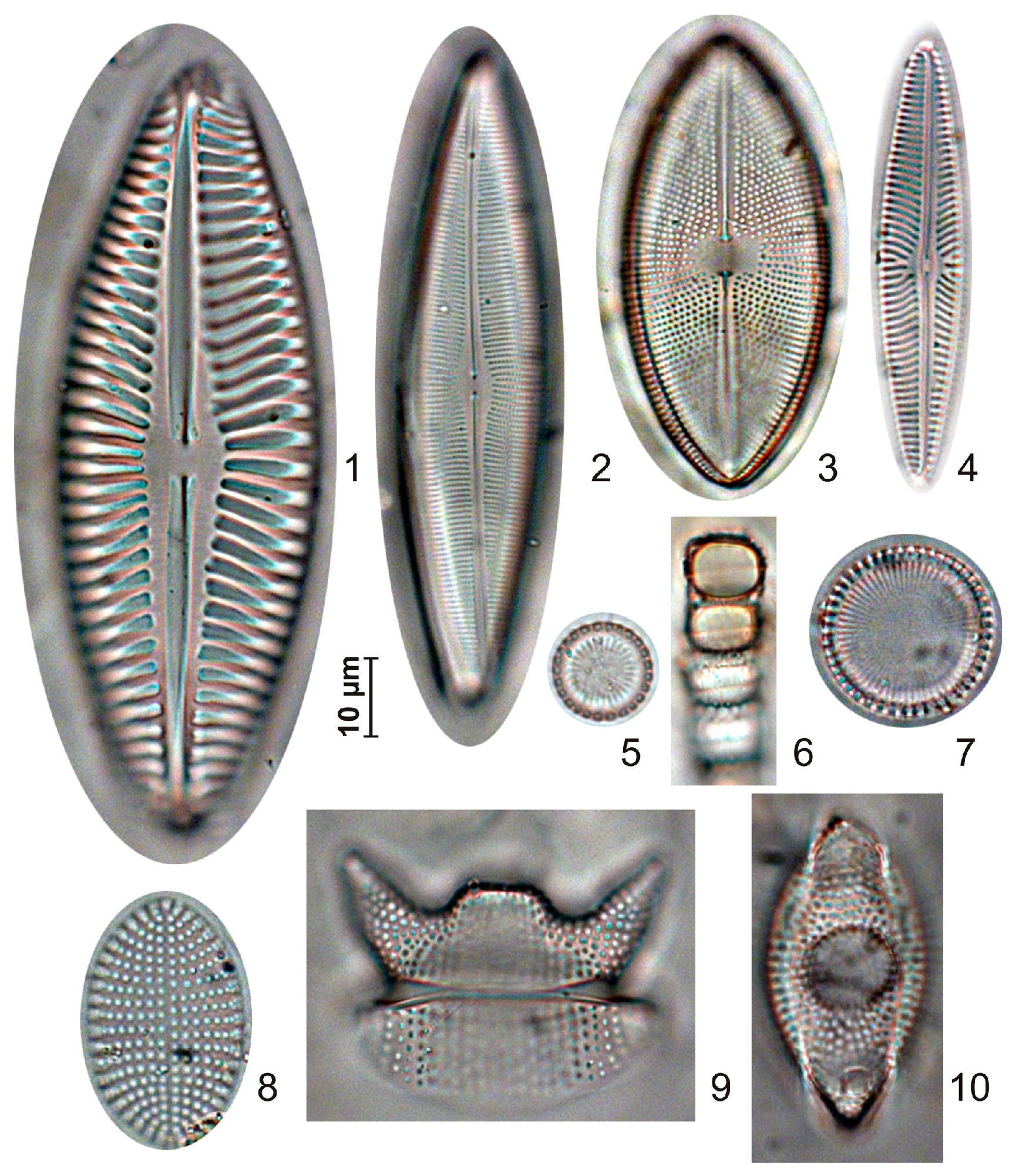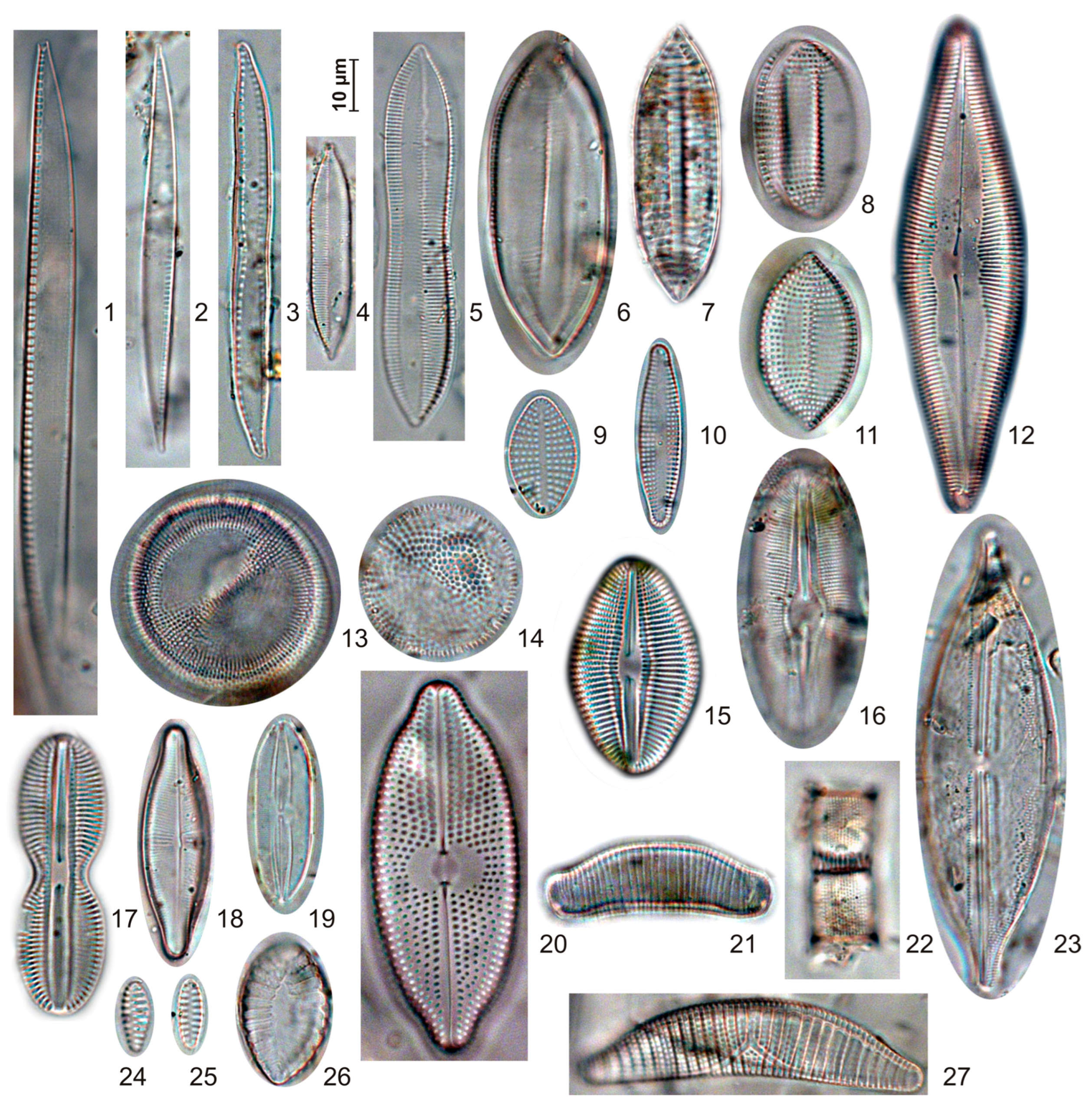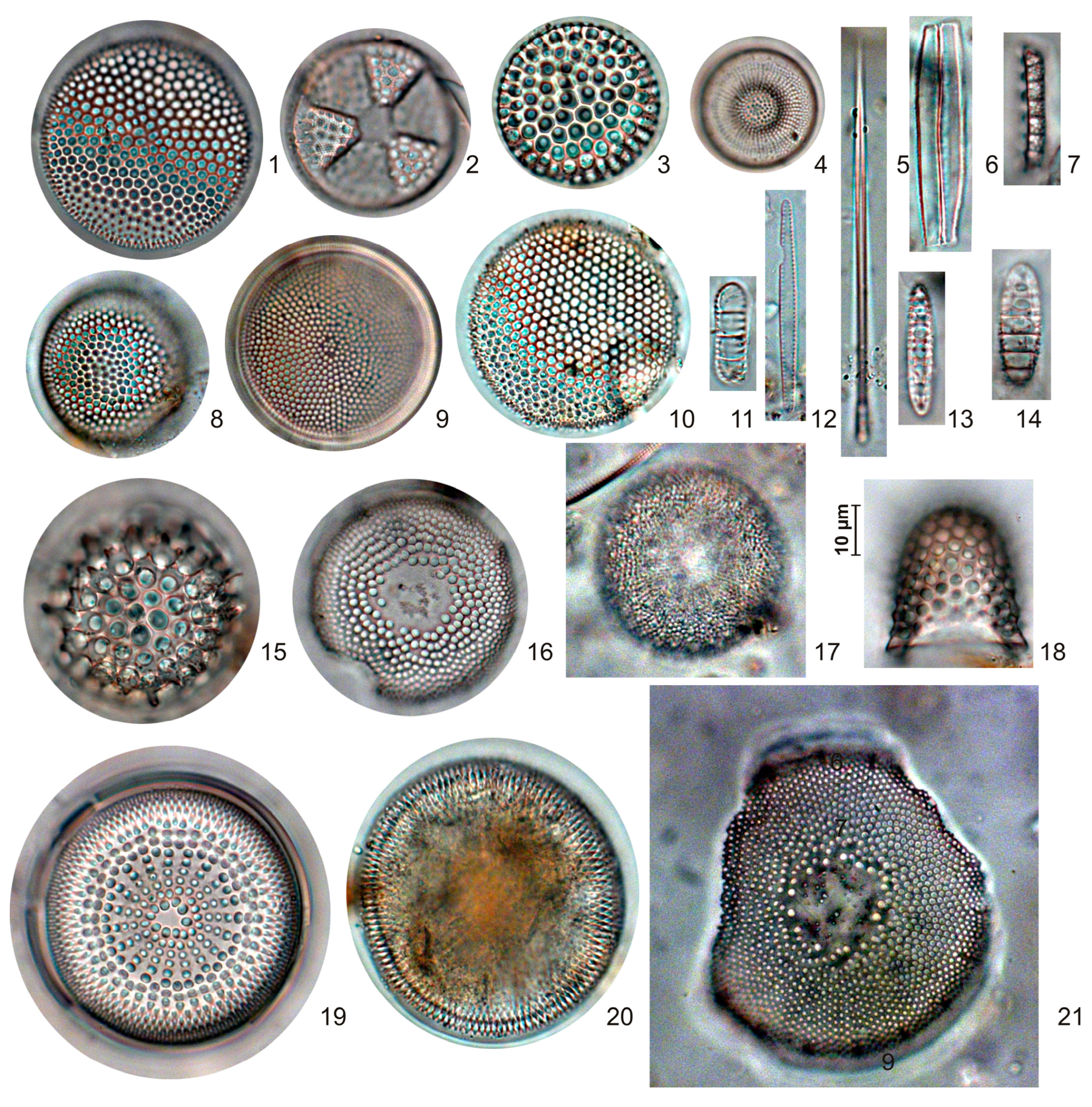Submitted:
08 August 2023
Posted:
09 August 2023
You are already at the latest version
Abstract
Keywords:
1. Introduction
2. Materials and Methods
2.1. Study Area
2.2. Sampling and treatment
3. Results
4. Discussion
5. Conclusions
Supplementary Materials
Author Contributions
Funding
Data Availability Statement
Acknowledgments
Conflicts of Interest
References
- Akiba, F.; Hiramatsu, Ch.; Tsoy, I.B.; Ogasawara, K.; Amano, K. Diatom biostratigraphy and geologic age of the Maruyama and Kurasi Formations, Southern Sakhalin, and their correlation to the Neogene of the Tenpoku Area, Hokkaido. J. Geography 2000, 109, 203–217. [Google Scholar] [CrossRef]
- Balashova, N.B. Diatom algae of thermal springs of Ussyk-Ata (Kyrgyz Ridge, Tian-Shan). Vestnik of St. Petersburg State University. Earth Sciences 2011, 3, 5–16. [Google Scholar]
- Bahls, L.; Potapova, M.; Fallu, M.-A.; Pienitz, R. Aulacoseira canadensis and Aulacoseira crassipunctata (Bacillariophyta) in North America. Nova Hedwigia 2009, 135, 167–184. [Google Scholar]
- Barinova, S.S.; Medvedeva, L.A.; Anissimova, O.V. Diversity of Algal indicators in environmental Assesment. Pile Studio Publ. House: Tel-Aviv, Israel, 2006.
- Barron, J.A. Planktonic marine diatom record of the past 18 M.Y.: Appearences and extinctions in the Pacific and Southern Oceans. Diatom Research 2003, 18, 203–224. [Google Scholar] [CrossRef]
- Cherepanova, M.V.; Lepskaya, E.V.; Anderson, P.; Lozhkin, A.V. Diatoms from Holocene sediments of the Nerpich'e Lake (Kamchatka). Issled. Vodn. Biol. Resur. Kamch. Sev.-Zap. Chasti Tikhogo Okeana 2013, 31, 89–106. [Google Scholar]
- Chudaev, D.A.; Gololobova, M.A. Diatom algae of Glubokoe Lake (Moscow region). Association of Scientific Publications KMK: Moscow, Russia, 2016.
- Derkachev, A.N.; Nikolaeva, N.A.; Tsoy, I.B.; Baranov, B.V. , Barinov, N.N., Mozherovsky, A.V.; Krylov, A.A.; Kuznetzov, A.B.; Minami, H.; Hachikubo, А. A Long-Lived Center of Gas-Fluid Emanations on the Kuril Basin Western Slope (Sea of Okhotsk). Lithology and Mineral Resources 2021, 4, 309–332. [Google Scholar] [CrossRef]
- Dimitrov, L.I. Mud volcanoes – a significant source of atmospheric methan. Geo-Mar. Lett. 2003, 23, 155–161. [Google Scholar] [CrossRef]
- Dzhumaeva, G.R. The algal flora of the main thermal and mineral springs of the Pamirs. Cand. Biol. Sciences Thesis. Institute of Botany of Academy of Sciences, Dushanbe, Republic of Tajikistan, 2008. http://www.dissercat.com/content/algoflora-osnovnykh-termalnykh-i-mineralnykh-istochnikovpamira (accessed on 25 July 2023).
- Fazlutdinova, A.; Gabidullin, Yu.; Allaguvatova, R.; Gaysina, L. Diatoms in Kamchatka's Hot Spring Soils. Diversity 2020, 12, 435. [Google Scholar] [CrossRef]
- Fazlutdinova, A.I.; Allaguvatova, R.Z.; Gaysina, L.A. Ecotonic Communities of Diatoms in the Southeastern Part of the Kamchatka Peninsula. Earth 2023, 4, 209–222. [Google Scholar] [CrossRef]
- Genkal, S.I.; Chekryzheva, T.A.; Komulaynen, S.F. Diatom algae in waterbodies and watercourses of Karelia. Scientific World: Moscow, Russia, 2015.
- Genkal, S.I.; Kulikovskiy, M.S.; Kuznetsova, I.V. The recent freshwater centric diatoms of Russia. Filigran: Yaroslavl, Russia, 2020.
- Genkal, S.I.; Yarushina, M.I. Diatom algae of poorly studied aquatic ecosystem in the Far North of Western Siberia. Scientific World: Moscow, Russia, 2017.
- Gladenkov, A.Yu. Diatom algae in the dating and correlation of the Cenozoic petroliferous sequences in Sakhalin. Proc. Section of Earth Sci. RANS 2008, 18, 125–134. [Google Scholar]
- Gladenkov, A.Yu.; White, L.D.; Gladenkov, Yu.B.; Blueford, J.R. Cenozoic biostratigraphy of the Pogranichnyi Region, Eastern Sakhalin, Russia. Palaeogeogr., Palaeoclimatol., Palaeoecol. 2000, 158, 45–64. [Google Scholar] [CrossRef]
- Gladenkov, Yu.B. (Ed.) Cenozoic ecosystems of the Okhotsk Sea region. GEOS: Moscow, Russia, 1999.
- Gladenkov, Yu.B.; Bazhenova, O.K.; Grechin, V.I.; Margulis, L.S.; Salnikov, B.A. The Cenozoic Geology and the Oil and Gas Presence in Sakhalin. GEOS: Moscow, Russia, 2002.
- Gladenkov, Yu.B.; Salnikov, B.A.; Brovtsev, A.K.; Boyarinova, M.E.; Voevodin, Yu.B.; Volobueva, V.I.; Kovtunovich, P.Yu.; Shantser, A.E. Resolution interdepartmental workshops on Paleogene and Neogene stratigraphy of Eastern Russia: Kamchatka, Koryak Upland, Sakhalin, and Kuril Islands. Explanatory note to stratigraphic schemes. GEOS: Moscow, Russia, 1998.
- Gleser, Z.I. Flora Plantarium Cryptogamarium URSS. Vol. VII. Silicoflagellatophyceae. Nauka: Moscow – Leningrad, USSR, 1966.
- Glezer, Z.I.; Makarova, I.V.; Moisseeva, A.I.; Nikolaev, V.A. (Eds.) Diatoms of USSR. Fossil and recent. Vol. II (2). St. Petersburg University Press: St. Petersburg, Russia, 1992.
- Hasle, G.R.; Syvertsen, E.E. Marine diatoms. Identifying Marine Phytoplankton. Academic Press: San Diego, USA, 1996.
- Hendey, N.I. An Introductory Account of the Smaller Algae of British Coastal Waters. Pt 5. Bacillariophyceae (Diatoms). Her Majest's Stationary Office: London, UK, 1964.
- Hobbs, W.O.; Wolfe, A.P.; Inskeep, W.P.; Amskold, L.; Konhauser, K.O. Epipelic diatoms from an extreme acid environment: Beowulf Spring, Yellowstone National Park, U.S.A. Nova Hedwigia 2009, 135, 71–83. [Google Scholar]
- Joh, G. Freshwater diatoms VII. Algal flora of Korea 3. National Institute of Biological Resources: Incheon, Republic of Korea, 2012b.
- Joh, G. Freshwater diatoms V. Algal flora of Korea 3. National Institute of Biological Resources: Incheon, Republic of Korea, 2012a.
- Joh, G.; Lee, J.H.; Lee, K.; Yoon, S.-K. Freshwater diatoms II. Algal Flora of Korea 3. National Institute of Biological Resources: Incheon, Republic of Korea, 2010.
- Jousé, A.P. Stratigraphic and paleogeographic studies in the Northwestern Pacific Ocean. Publishing House of the USSR Academy of Sciences: Moscow, USSR, 1962.
- Jousé, A.P.; Proshkina-Lavrenko, A.I.; Sheshukova-Poretskaya, V.S. Research methodology, In: Gleser, Z.I., Jousé, A.P.; Makarova, I.V., Ed.; Proshkina-Lavrenko, A.I. (Eds.). Diatom algae of the USSR. Fossil and Recent. Vol. I. Nauka Publishing House: Moscow, USSR, 1974; pp. 50–79. [Google Scholar]
- Khlystov, O.M.; Minami, H.; Hachikubo, A.; Yamashita, S.; De Batist, M.; Nauds, L.; Khabuev, A.V.; Chenskiy, A.G.; Gubin, N.A.; Vorobyeva, S.S. Age of mud breccia from mud volcanoes in Academician Ridge, Lake Baikal. Geodynamics and Tectonophysics. 2017, 8, 923–932. [Google Scholar] [CrossRef]
- Kholodov, V.N. On origin of mud volcanoes. Priroda 2002, 11, 47–58. [Google Scholar] [CrossRef]
- Kopf, A.J. Significance of mud volcanism. Reviews of Geophysics 2002, 40, 1005. [Google Scholar] [CrossRef]
- Korneva, L.G. Phytoplankton of Volga River basin reservoirs. Kostroma Publishing House: Kostroma, Russia, 2015.
- Korznikov, K.A. Mud volcano of the Sakhalin Island within the regional system of natural protection areas. Vestnik Moskovskogo Universiteta. Ser. 5, Geografiya 2014, 5, 34–39. [Google Scholar]
- Korznikov, K.A. Vegetation cover of mud volcanoes on Sakhalin Island. Cand. Biol. Sciences Thesis, . Moscow State University, Moscow, Russia, 2015. [Google Scholar]
- Kovtunovich, P.Yu.; Chumakov, L.M.; Tsoy, I.B. New data on the ages of the Matituk and Pomyr formations of Northern Sakhalin. Russ. J. Pacific Geol. 2018, 12, 303–319. [Google Scholar] [CrossRef]
- Kulikovskiy, M.S.; Glushchenko, A.M.; Genkal, S.I.; Kuznetsova, I.V. Identification book of diatoms from Russia. Filigran: Yaroslavl, Russia, 2016.
- Labai, V.S.; Pecheneva, N.V. Сomparative characteristics of the distribution, composition and structure of freshwater zoobenthos of the Piltun and Nyiskiy Bay lagoons (North-Eastern Sakhalin). In: V.Y. Levanidov's Biennial Memorial Meetings. Issue 1. FSCEATB FEB RAS: Vladivostok, Russia, 2001, pp. 55-64.
- Lai, G.G.; Beauger, A.; Wetzel, C.E.; Padedda, B.M.; Voldoir, O.; Luglie, A.; Allain, E.; Luc, E. Diversity, ecology and distribution of benthic diatoms in thermos-mineral springs in Auvergne (France) and Sardinia (Italy). PeerJ. 2019, 7, e7238. [Google Scholar] [CrossRef]
- Leira, M.; Meijide-Failde, R.; Torres, E. Diatom communities in thermo-mineral springs of Galicia (NW Spain). Diatom Research 2017, 32, 29–42. [Google Scholar] [CrossRef]
- Makarova, I.V. (Ed.) Diatoms of Russia and adjacent countries. Fossil and Recent, Vol. II (3). St. Petersburg University Press: St. Petersburg, Russia, 2002.
- Margulis, L.S. Petroleum-geological zoning and estimating the oil-gas resources of the Far Eastern seas. Neftegasovaya geologiya. Teori I Practica 2009, 4, 1–17. [Google Scholar]
- Mazzini, A.; Etiope, G. Mud volcanism: An updated review. Earth-Science Reviews 2017, 168, 81–112. [Google Scholar] [CrossRef]
- Medvedeva, L.A. First results of algological study of Dagi River (Sakhalin Island). In: Makarchenko, E.A. (Ed.), Freshwater Life. Vol. 1. Dalnauka: Vladivostok, Russia, 2013.
- Melnikov, O.A.; Ilyev, A.Ya. On new manifestations of mud volcanism on Sakhalin. Tikhookeanskaya Geologiya 1989, 3, 42–49. [Google Scholar]
- Melnikov, O.A.; Ershov, V.V. Mud (gas-water-lithoclastite) volcanism of the Sakhalin Island: history, results and prospects in research. Vestnik of Far Eastern Branch of Russian Academy of Sciences 2010, 6, 87–93. [Google Scholar]
- Mpawenayo, B.; Mathooko, J.M. Diatom assemblages in the hot springs associated with Lakes Elmenteita and Baringo in Kenya. African J. Ecology 2004, 42, 363–367. [Google Scholar] [CrossRef]
- Nikulina, T.V. Biodiversity of algae of hot springs from the Kuril Islands (Russia). Intern. J. on Algae 2010, 12, 299–320. [Google Scholar] [CrossRef]
- Nikulina, T.V.; Grishchenko, O.V. Diatom flora of Dachnye thermal springs (Kamchatka Peninsula, Russia), In: V.Y. Levanidov's Biennial Memorial Meetings. Issue 7. FSCEATB FEB RAS: Vladivostok, Russia, 2017.
- Nikulina, T.V.; Kalitina, E.G.; Kharitonova, N.A.; Chelnokov, G.A.; Vakh, E.A.; Grishchenko, O.V. Diatoms from hot springs of the Kamchatka Peninsula (Russia). In: Diatoms: Fundamentals and Applications. Vol. 1. Seckbach, J., Gordon, R. Eds.; Scrivener Publishing: Beverly, USA, 2019. Beverly, USA.
- Nikulina, T.V.; Kalitina, E.G.; Vakh, E.A.; Kharitonova, N.A. List of diatoms from three hot springs from Kamchatka – Malkinskiye, Nachikienskiye, and Verkhneparatunskiye (Russia), In: Freshwater Life, Vol. 2. Bogatov, V.V. Chief Ed.; Dalnauka: Vladivostok, Russia, 2016.
- Nikulina, T.V.; Kociolek, J.P. Diatoms from Hot Springs from Kuril and Sakhalin Islands (Far East, Russia). The Diatom World, Cellular Origin, Life in Extreme Habitats and Astrobiology. Seckbach, J., Kociolek, P., Eds.; Springer Science, Business Media B.V., 2011.
- Nikulina, T.V.; Medvedeva, L.A. Diatoms of the southern part of the Russian Far East, In: Diatoms: Fundamentals and Applications. Vol. 1. Scrivener Publishing: Beverly, MA, USA, 2019.
- Niyatbekov, T.P.; Barinova, S.A. Diatoms (Bacillariophyta) of the thermal and mineral water sources of Pamir. Biodiversity and environment of protected areas 2018, 2, 5–23. [Google Scholar]
- Obrezkova, M.S. Diatom flora of surface sediments of the Amur River estuary and adjacent areas of the Sea of Japan and the Sea of Okhotsk. Russ. J. Mar. Biol. 2009, 2, 138–150. [Google Scholar] [CrossRef]
- Owen, R.B.; Renaut, R.W.; Jones, B. Geothermal diatoms: a comparative study of floras in hot spring systems of Iceland, New Zealand, and Kenya. Hydrobiologia 2008, 610, 175–192. [Google Scholar] [CrossRef]
- Park, J.; Khim, J.S.; Ohtsuka, T.; Araki, H.; Witkowski, A.; Koh, C.H. Diatom assemblages on Nanaura mudflat, Ariake Sea, Japan: with reference to the biogeography of marine benthic diatoms in Northeast Asia. Botanical Studies 2012, 53, 105–124. [Google Scholar]
- Pavlova, V.Yu.; Zharkov, R.V. GPR surveys of the discharge zone of the Daginsky hydrothermal system (Sakhalin Island). Geosystems of transition zones, 2018; 2/4, 323–331. [Google Scholar] [CrossRef]
- Pearce, R.B.; Kemp, A.E.S.; Koizumi, I.; Pike, J.; Cramp, A.; Rowland, S.J. A lamina-scale, SEM-based study of a late Quaternary diatom-ooze sapropel from the Mediterranean Ridge, Site 971. Proc. of the Ocean Drilling Program, Scientific Results, 1998, 160, pp. 349–363. [Google Scholar] [CrossRef]
- Proschkina-Lavrenko, A.I. (Ed.) . Diatom Analysis. Keys for Identification of Fossil and Recent Diatoms. Book 2. Gosgeolizdat: Leningrad, USSR, 1949.
- Proschkina-Lavrenko, A.I. (Ed.) . Diatom analysis. Keys for Identification of Fossil and Recent Diatoms. Book 3, Gosgeolizda:, Leningrad, USSR, 1950.
- Pumas, C.; Pruetiworanan, S.; Peerapornpisal, Yu. Diatom diversity in some hot springs of northern Thailand. Botanica 2018, 24, 69–86. [Google Scholar] [CrossRef]
- Pushkar, V.S.; Cherepanova, M.V. Diatom assemblages and correlation of Quaternary sediments of the Northwest Pacific Ocean. Dalnauka: Vladivostok, Russia, 2008.
- Quintela, A.; Almeida, S.F.P.; Terroso, D.; Da Silva, E.F.; Forjaz, V.; Rocha, F. Diatom assemblages of thermal and mineral waters from volcanic environments in S?o Miguel. Island, Azores. Diatom Research 2013, 28, 407–417. [Google Scholar] [CrossRef]
- Quintela, A.; Almeida, S.P.F.; Terroso, D.; Da Silva, E.F.; Forjaz, V.; Rocha, F. Chemical Modifications and Diatom Community Development on Volcanic Clayey Sediments during an Indoor Maturation Experiment. Geomicrobiological Journal 2015, 32, 103–112. [Google Scholar] [CrossRef]
- Round, F.E.; Crawford, R.M.; Mann, D.G. The Diatoms: Biology and morphology of the genera. Cambridge University Press: Cambridge, MA, USA, 1990.
- Ryabushko, L.I.; Begun, A.A. Diatoms of the microphytobenthos of the Sea of Japan (Synopsis and Atlas). Vol. 2. KIA: Sevastopol, Russia, 2016.
- Ryabushko, L.I.; Bondarenko, A.V. Microalgae of mud volcano of the Bulganak sopochnoe field on the Crimean Peninsula. Marine Biological J. 2020, 5, 64–77. [Google Scholar] [CrossRef]
- Ryabushko, L.I.; Tarasov, V.G. Qualitative composition of diatoms of microphytobenthos of Kraternaya Bight. Biologiya Morya 1989, 3, 83–88. [Google Scholar]
- Sakharov, V.A.; Il'in, V.V.; Morozova, O.A.; Vypryazhkin, E.N.; Khi, I.K.; Gogoleva, I.V. Daginsky deposit of thermal mineral waters. Formation conditions, current state, projects for use (Sakhalin Region). Bull. Tomsk Polytechnic University. Geo Assets Engineering 2020, 331, 13–26. [Google Scholar] [CrossRef]
- Schoeman. F.R.; Archibald, R.E.M. Taxonomic notes on the diatoms (Bacillariophyceae) of the Gross Barmen thermal springs in South West Africa/Namibia. South African J. Botany 1988, 54, 221–256. [Google Scholar] [CrossRef]
- Semina, H.J. Pacific Phyroplankton. Publishing House Nauka: Moscow, USSR, 1974.
- Shakirov, R.; Obzhirov, A.; Suess, E.; Saluyk, A.; Biebow, N. Mud volcanoes and gas vents in the Okhotsk Sea area. Geo-Mar. Lett. 2004, 24, 140–149. [Google Scholar] [CrossRef]
- Shakirov, R.B.; Sorochinskaja, A.V.; Syrbu, N.S.; Tsoy, I.B.; Hoang, N.; Anh, L.D. Geochemical features of Sakhalin Island mud volcanoes. Vietnam J. Earth Sciences 2018, 40, 56–69. [Google Scholar] [CrossRef]
- Sheshukova-Poretzkaya, V.S. Neogene marine diatom algae of Sakhalin and Kamchatka. Leningrad State University Publishing House: Leningrad, USSR, 1967.
- Shirokov, B.D. , 1974. Underground waters and therapeutic mud, In: Sidorenko, A.V. (Chief Ed.), Vereshchagin, V.N., Kovtunovich, Y.PM. (Eds.), Geology of the USSR, Vol. 33. The Sakhalin Island. Mineral resources. Nedra Publishers: Moscow, USSR, pp. 160–184.
- Shnyukov, E.; Yanko-Gombakh, V. Mud volcanoes of the Black Sea Region and their environmental Significance. Springer Nature Switzerland AG, Switzerland, 2020. [CrossRef]
- Sidorenko, A.V.; Vereshchagin, V.N.; Kovtunovich, Y.M. (Eds). Geology of the USSR. V. 33. Sakhalin Island. Nedra Publishers: Moscow, USSR, 1970.
- Siryk, I.M., 1970. Mud volcanoes. In: Sidorenko, A.V.; Vereshchagin, V.N.; Kovtunovich, Y.M. (Eds.). Geology of the USSR. Vol. 33. The Sakhalin Island. Geological description. Nedra Publishers: Moscow, USSR, 1970, pp. 355–368.
- Sorochinskaya, A.V.; Shakirov, R.B.; Venikova, A.L.; Pestrikova, N.L. Elements-admixtures in the modern mud breccias on the mud volcanoes in Sakhalin Island. Bull. of Kamchatka Regional Association "Educational-Scientific Center". Earth Sciences 2015, 25, 19–30. [Google Scholar]
- Strelnikova, N.I. (Ed.) . Diatoms of Russia and adjacent countries. Fossil and Recent. Vol. II (4). St. Petersburg University Press: St. Petersburg, Russia, 2006.
- Strelnikova, N.I.; Gladenkov, A.Yu. Diatoms and their application in stratigraphic and paleogeographic studies. Issues of Modern Algology 2019, 2, 1–48. [Google Scholar] [CrossRef]
- Strelnikova, N.I.; Tsoy, I.B. (Eds.) Diatoms of Russia and adjacent countries. Fossil and Recent. Vol. II (5). St. Petersburg University Press: St. Petersburg, Russia, 2008.
- Tolomio, C.; Ceschi-Berrini, C.; Moschin, E.; Galzigna, L. Colonization by Diatoms and Antirheumatic Activity of Thermal Mud. Cell Biochemistry and Function 1999, 17, 29–33. [Google Scholar] [CrossRef]
- Tsitenko, N.D. Mud volcanoes in the Daginsky district of Sakhalin Island, In: Research on the geology and oil and gas potential of Sakhalin. Trudy VNIGRI 1961, 181, 171–175. [Google Scholar]
- Tsitenko, N.D. The waters of Daginsky hot springs on the Sakhalin Is. (to the question of the formation of the chemical composition of chlorine calcium waters). In: Research on the geology and oil and gas potential of Sakhalin. Trudy VNIGRI 1961, 181, 203–212. [Google Scholar]
- Tsoy, I.B.; Emelyanova, E.A. Atlas of diatom Algae from the Daginsky Mud Volcano (East Sakhalin). POI FEB RAS: Vladivostok, Russia, 2021. [CrossRef]
- Tsoy, I.B.; Moiseenko, I.A. Diatoms from surface sediments of Amurskiy Bay, Sea of Japan. Russ. J. Mar. Biol. 2014, 40, 10–23. [Google Scholar] [CrossRef]
- Tsoy, I.B.; Obrezkova, M.S.; Artemova, A.V. Diatoms in Surface Sediments of the Sea of Okhotsk and the Northwest Pacific Ocean. Oceanology 2009, 1, 130–139. [Google Scholar] [CrossRef]
- Tsoy, I.B.; Prushkovskaya, I.A. Diatoms in Surface Sediments of Academy Bay of the Sea of Okhotsk. Russ. J. Mar. Biol. 2023, 49, 75–86. [Google Scholar] [CrossRef]
- Yakubov, A.A.; Grigoryants, B.V.; Aliev, Ad.A.; Babazade, A.D.; Veliyev, M.M.; Hajiyev, Ya.A.; Huseynzade, I.G.; Kabulova, A.Ya.; Kastryulin, N.S.; Matanov, F.A.; Mustafayev, M.G.; Rakhmanov, R.R.; Safarova, O.B.; Seidov, A.G. Mud volcanism of the Soviet Union and its connection with oil and gas potential. Ed. Yakubova. A. Elm Publishing House: Baku, Azerbaijan, 1980.
- Yanagisawa, Y.; Akiba, F. Refined Neogene diatom biostratigraphy for the northwest Pacific around Japan, with an introduction of code numbers for selected diatom biohorizons. J. Geol. Soc. Japan 1998, 104, 395–414. [Google Scholar] [CrossRef]
- Zharov, A.E.; Mitrofanova, L.I.; Tuzov, V.P. Cenozoic stratigraphy of the northern Sakhalin shelf. Stratigraphy and Geological Correlation 2013, 21, 531–552. [Google Scholar] [CrossRef]









| Sample Number |
Latitude, N | Longitude, E | Sediment Type |
|---|---|---|---|
| D01-1 | 52°02′50″ | 143°05′38″ | clayey silt |
| D12-1 | 52°02′50″ | 143°05′41″ | clayey silt |
| D12-2 | 52°02′52″ | 143°05′42″ | clayey silt |
| D12-4 | 52°02′51″ | 143°05′39″ | clayey silt |
| D12-6 | 52°02′48″ | 143°05′40″ | clayey silt |
| T2-6 | 52°02′50.1″ | 143°05’42.7″ | compacted silt |
| T3-7 | 5 m south-west of T2-6 | clayey silt | |
| T4-8 | 52°02′48.8″ | 143°05′41.5″ | clayey silt |
| T1-1 | 52°02′58.8″ | 143°05′38.8″ | clayey silt |
| T1-2 | “–” | “–” | clayey silt |
| T1-3 (10–11 cm) | “–” | “–” | compacted silt |
| T1-4 (30–31 cm) | “–” | “–” | compacted silt |
| T1-5 (40–41 cm) | “–” | “–” | compacted silt |
Disclaimer/Publisher’s Note: The statements, opinions and data contained in all publications are solely those of the individual author(s) and contributor(s) and not of MDPI and/or the editor(s). MDPI and/or the editor(s) disclaim responsibility for any injury to people or property resulting from any ideas, methods, instructions or products referred to in the content. |
© 2023 by the authors. Licensee MDPI, Basel, Switzerland. This article is an open access article distributed under the terms and conditions of the Creative Commons Attribution (CC BY) license (http://creativecommons.org/licenses/by/4.0/).





